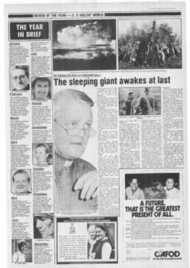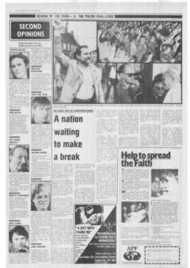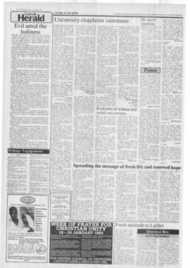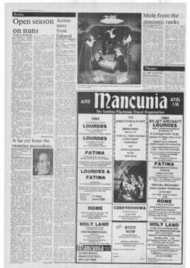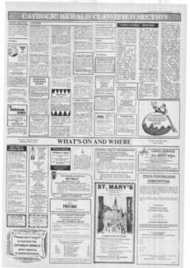Page 2, 23rd December 1983
Page 2

Report an error
Noticed an error on this page?If you've noticed an error in this article please click here to report it.
Tags
Share
Related articles
Milingo Africa's Exorcist
Africa's Archbishop Of No Fixed Abode
Is That Really An Ex-archbishop On The Beach?
Rome Church For Healing Archbishop
African Archbishop's Moonie Wedding Stuns The Church
Rome Talks On Milingo
Steam up in the engine room
Thorny problem : Archbishop Milingo.
TO THE outside world — which often means those people on the outside of the television screen — Pope John Paul seems to have spent most of his year making fruitless appeals for peace around the world and for the release of kidnapped children.
For those who share his faith it is of more interest to try to discern a pattern or programme of action within the Pope's astonishiug level of activity. And it is astonishing — not just for a man who was within inches of death two years ago when bullets gouged their way through his body.
Pope John Paul can hardly be accused of shrugging off problems, An open letter to him from Mgr Bruce Kent published in this newspaper in January might not have loomed largest among these, though its general theme — peace — certainly has. "We need you with us, not against quoted against us," wrote Mgr Kent in an appeal for the Pope to speak clearly on disarmament lest his words be used by the enemies of CND as ammunition against them.
Just over a month later, Pope John Paul stepped straight into a theatre of war with his two week tour of six countries in Central America. Of these, Costa Rica has no armed forces at all (though it is used as a base by the ex-Sandinista led wing of the counter-revolutionary guerrillas fighting the Nicaraguan regime). But in El Salvador the Pope sampled some of the flavour of right-wing repression and freelance terror.
It was Nicaragua that presented the most puzzling profile of Church involvement. The increasingly Marxist influenced Sandinista government, in direct line from the revolutionaries . who overthrew the vile Somoza regime, retains among its ministers Fr Ernesto Cardenal, a poetically-minded Jesuit. He knelt before the Pope in his beret and tee-shirt and the Pope wagged his finger at him. But last week Fr Cardenal announced his intention of staying in the government, on the grounds that the Pope's request to "sort things out" was open to various interpretations. The Pope's visit seemed not to make the slightest difference.
While he was in Nicaragua, the government-organised public Mass, orchestrated as a revolutionary rally, turned into a shouting match when relatives of murder victims demanded that the Pope should say something to them. The microphones were thrned off and the Pope's voice could not be heard. But he did hold up his crucifix-staff (no cross had been provided on the altar) and brandish it at the crowd. That seemed to be his answer, though not a simple one. The Cross figured too in the Pope's decision to mount a Holy Year unexpectedly. On April 1 the Holy Year of the Redemption (1,950 years since the Crucifixion) began. 'And the theme of the Easter message was solidarity with the suffering, through union with Christ.
It must have been clear that the Pope's ideals of penance were not shared by many of his flock. The World Synod of Bishops was clearly designed to adjust the position. Its theme of reconciliation embraced peace as well as penance, with a certain practical question of how to get people to the Sacrament again.
Meanwhile Pope John Paul was busy with paper work. He had already gone through the new Code of Canon Law item by item, so that its publication was delayed until early this year. Apart from his regular messages for peace, unity, missions and vocations, he must have paid attention to the final draft of the
long-awaited document on sexeducation and the Family Rights Charter (the fruit of a previous Bishops' Synod). Family life is one of the Pope's specialities.
During his regular work of
writing, and meeting individually scores of bishops on ad limina visits, the Pope continued his practice of showing himself to be the Bishop of Rome with a series of Sunday visits to Rome parishes. He even found time to go to the opera while the guest of Italy's largest diocese, Milan.
One of the bishops whom the Pope spoke to presented more difficulties than most. The intractible problem of Archbishop Milingo of Lusaka, who has been in Rome for 18 months while his diocese was under the care of an administrator and split with dissension, had to be settled somehow. Whether or not it was the Pope's idea, the Archbishop, who among other things had been accused by detractors of wizardry, was kicked upstairs into a curial cul-de-sac as an official in the department of tourism and migration.
Negotiations of equal complexity led to the Pope's triumphal return to his homeland in June. Crowds surrounded him with victory signs and the government was neutralised for a few days. Return to Rome was marred by another scandal — the acting editor of L'Osservatore Romano had to be sacked for claiming to
reveal what the Pope said to Lech Walesa.
Even if their conversation had little in the way of optimistic
encouragement for the Solidarity leader, the Pope's telegram of congratulation when Walesa was named as Nobel Peace Prize winner restored the almost visible link between the supporters of Solidarity (in one way almost the whole Polish mation) and the Polish Pope.
Two more Papal visits engaged public interest in August and September — to Lourdes and Austria. Lourdes was the postponed pilgrimage of thanksgiving for recovery from the assassination attempt. Austria marked the 300th anniversary of the defeat of the Turks (and the preservation of European Christianity) at Vienna by the Pope's fellowcountryman King John Sobieski. Beatification and canonisation seem to increase as the Pope's reign goes on. The process of Fra Angelico the renaissance painter began and Sr Gabriella Sagheddu, who gave her life for unity, was made blessed. A new saint Leopold, from Yugoslavia, was created. His special vocation took in two of the Pope's preoccupations — the Sacrament of Penance and the reconciliation of the Eastern and Western churches.
The decision to go ahead with the process of canonisation of the martyrs of the Spanish Civil War brought grumbles from those could not allow that any on the Nationalist side were really Christian, and the visit this month to a Lutheran church in Rome annoyed those who feared contamination by false religions — notably Archbishop Lefebvre, whose repeatedly predicted reconciliation with the Holy See refused to materialise.
Nearer home, the Pope was polite to a joint delegation of Catholics and members of the British Council of Churches who went to see him in Rome. And he was careful to say a Mass of unity and have kind words for the Jesuits whom he had finally allowed to choose themselves a new General, after being put under a personal delegate of the Holy See until they had seined themselves out. Unlike Fr Cardenal, they seemed in the Pope's eyes to have done so.
Whatever else it shows, the past year of Pope John Paul's reign reveals no decrease in momentum. The Pope's energetic programme has kept up steam for more than five years. And the Church is changing gear to keep pace.
blog comments powered by Disqus




